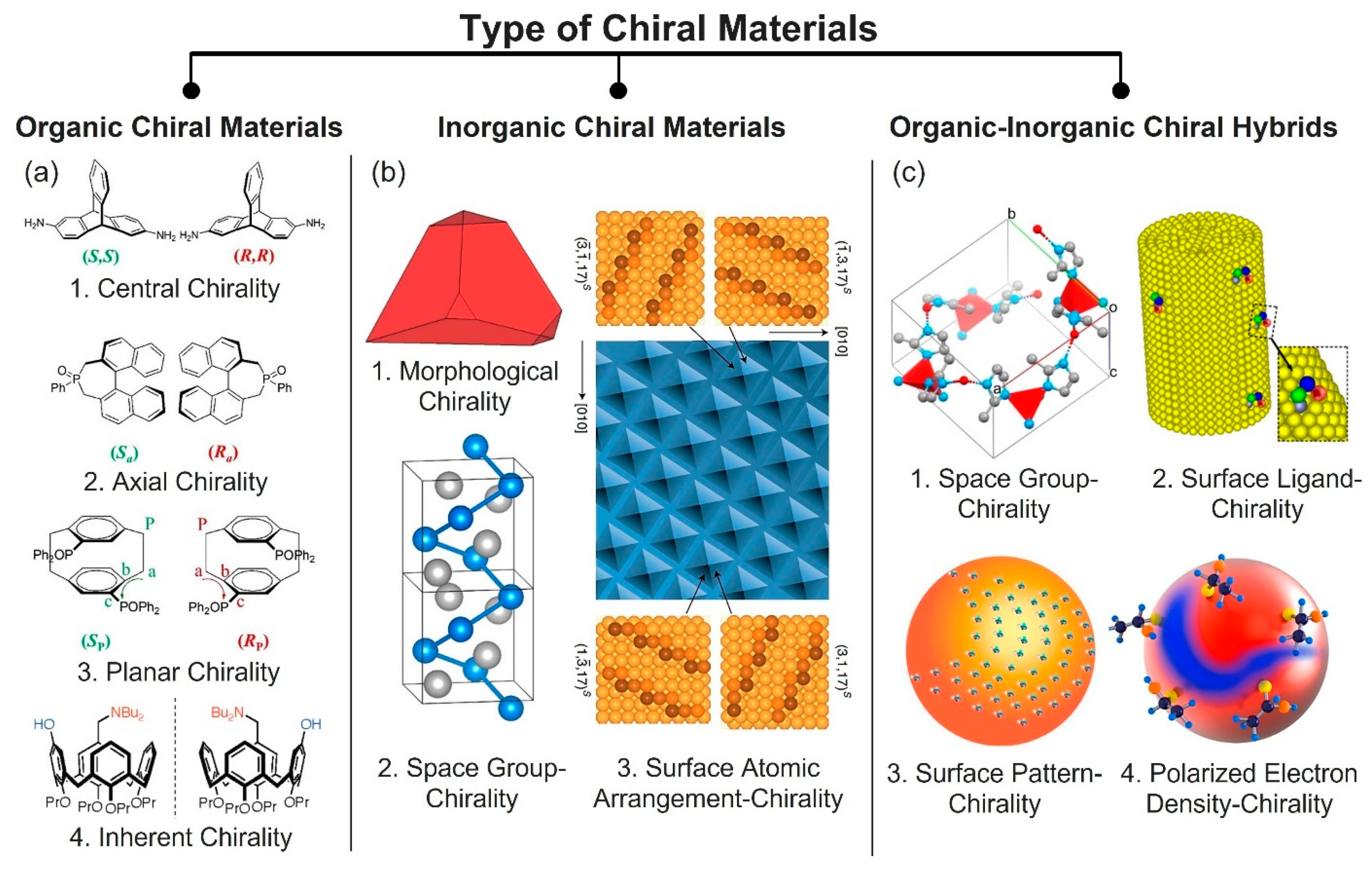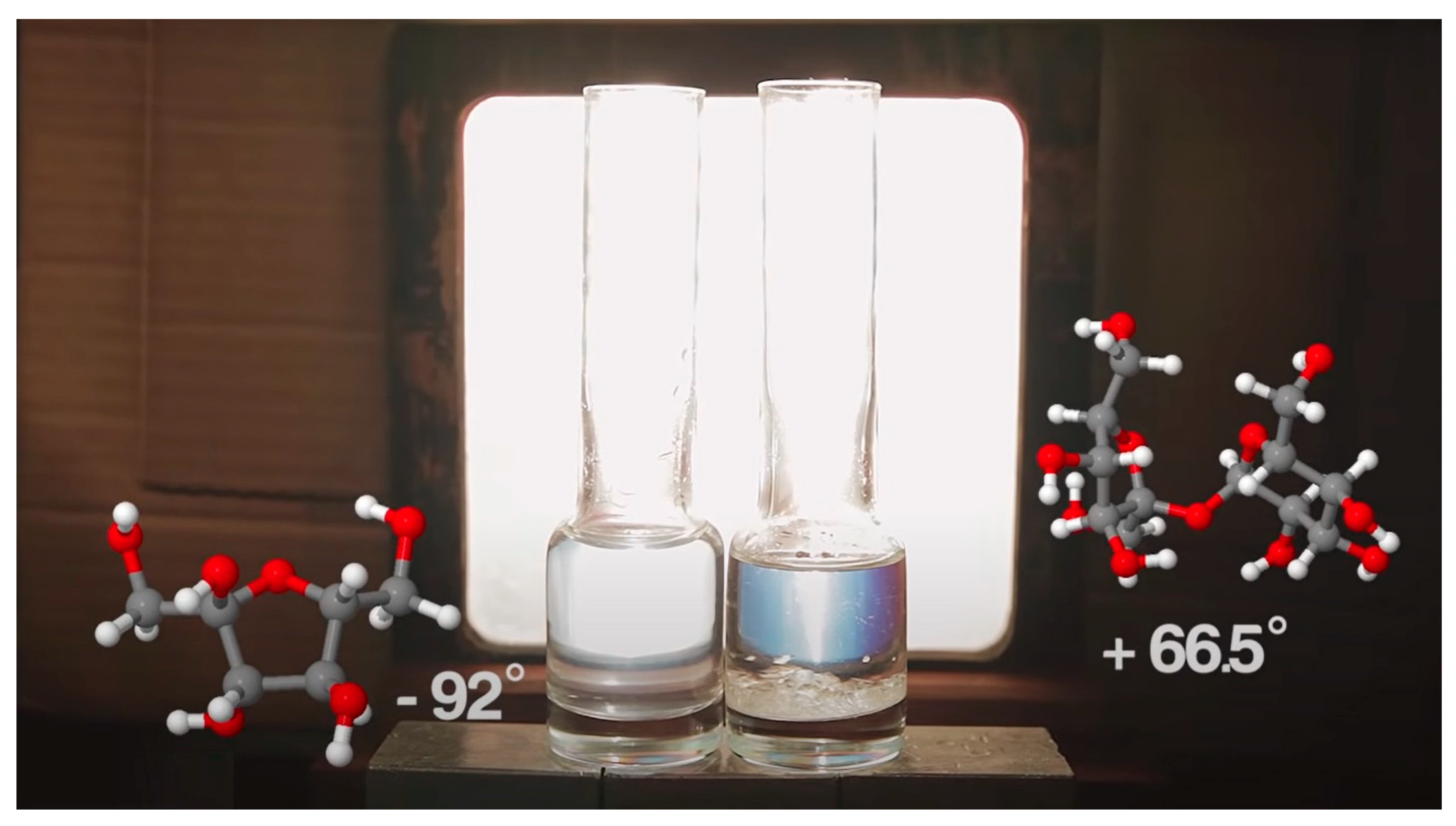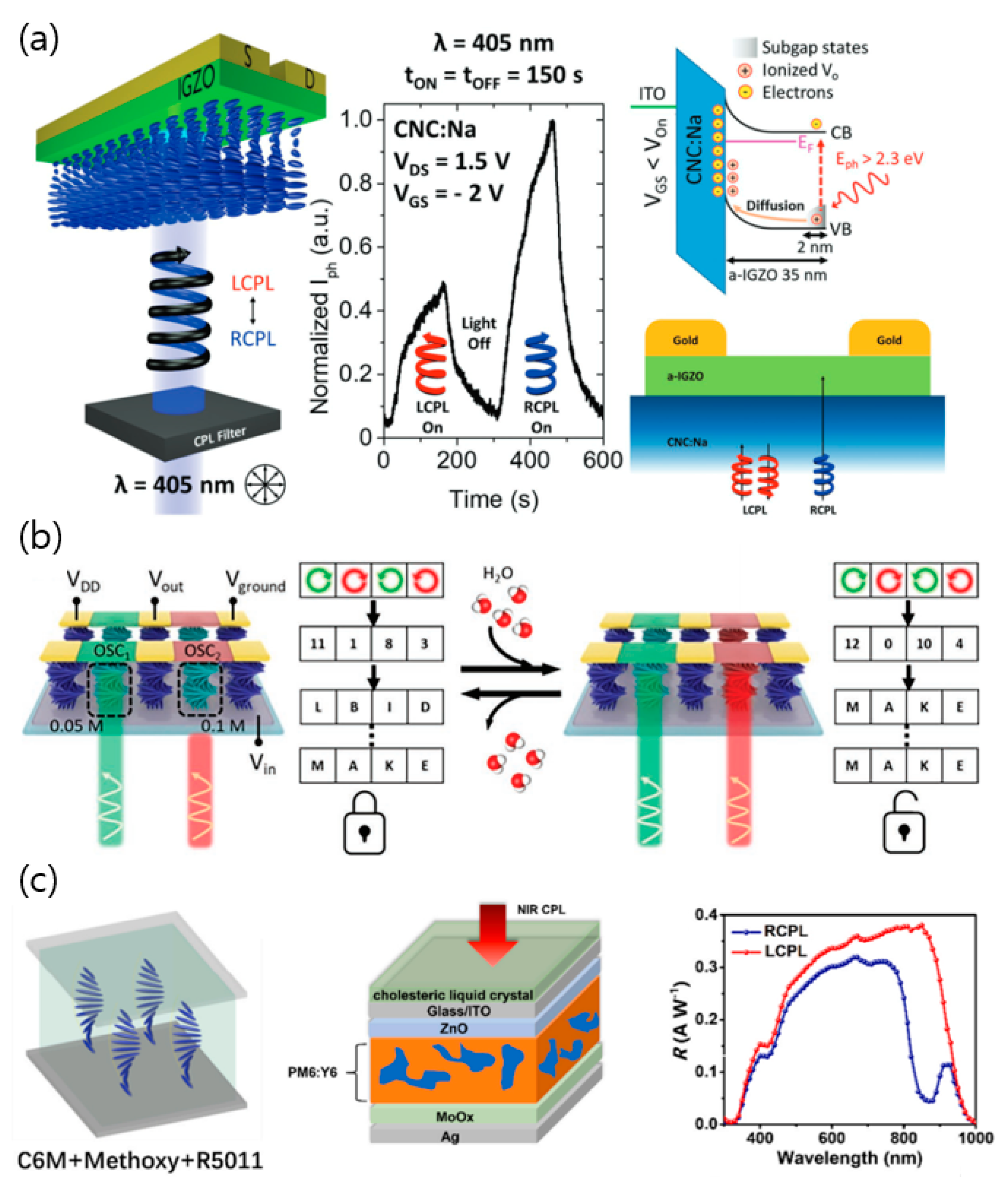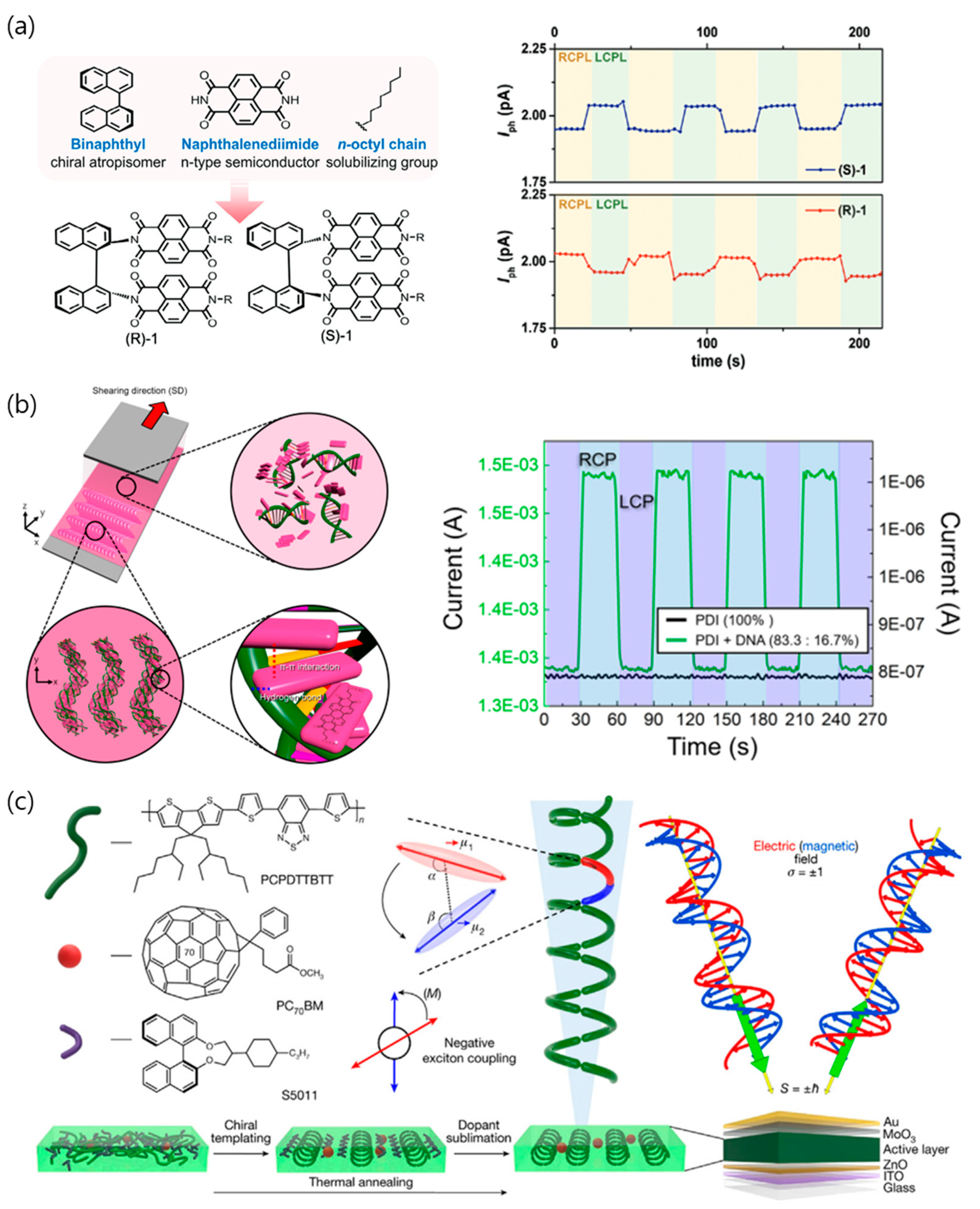Chiral Materials for Optics and Electronics: Ready to Rise?
Abstract
:1. Introduction
2. Classification of Chiral Materials Depending on the Chemical Composition
2.1. Organic Chiral Materials
2.2. Inorganic Chiral Materials
2.3. Organic-Inorganic Hybrid-Chiral Materials
3. Optical Applications of Chiral Materials
3.1. Light Controls
3.2. Sensing

4. Chiro-Electronics
4.1. Device Structure with Operating Mechanisms of Photoconductors, Photodiodes, and Phototransistors
4.1.1. Device Structure
4.1.2. Operating Mechanisms of Photoconductors, Photodiodes, and Phototransistors
4.2. Important Parameters of Circularly Polarized Light in Optoelectronics
4.3. Strategies of CPL Detection for High Performance
4.3.1. Cholesteric Liquid Crystals
4.3.2. Heterojunction via Chiral Templating and Doping Treatment
5. Concluding Remarks and Perspective
Author Contributions
Funding
Data Availability Statement
Conflicts of Interest
References
- Kim, M.; Tsukruk, V.V. Spectroscopy finds chiral phonons. Nat. Photonics 2022, 16, 337–338. [Google Scholar] [CrossRef]
- Kelvin, W.T.B. Baltimore Lectures on Molecular Dynamics and the Wave Theory of Light; CJ Clay and Sons: London, UK, 1904. [Google Scholar]
- Popular Information. NobelPrize.org. Nobel Prize Outreach AB 2024. Available online: https://www.nobelprize.org/prizes/chemistry/2021/popular-information/ (accessed on 15 January 2024).
- Grande, C.; Patel, N.H. Nodal signalling is involved in left–right asymmetry in snails. Nature 2009, 457, 1007–1011. [Google Scholar] [CrossRef] [PubMed]
- Gautier, C.; Bürgi, T. Chiral gold nanoparticles. ChemPhysChem 2009, 10, 483–492. [Google Scholar] [CrossRef] [PubMed]
- Choi, W.J.; Yano, K.; Cha, M.; Colombari, F.M.; Kim, J.-Y.; Wang, Y.; Lee, S.H.; Sun, K.; Kruger, J.M.; de Moura, A.F. Chiral phonons in microcrystals and nanofibrils of biomolecules. Nat. Photonics 2022, 16, 366–373. [Google Scholar] [CrossRef]
- Nguyen, H.V.-T.; Jiang, Y.; Mohapatra, S.; Wang, W.; Barnes, J.C.; Oldenhuis, N.J.; Chen, K.K.; Axelrod, S.; Huang, Z.; Chen, Q. Bottlebrush polymers with flexible enantiomeric side chains display differential biological properties. Nat. Chem. 2022, 14, 85–93. [Google Scholar] [CrossRef] [PubMed]
- Han, M.J.; Kim, M.; Tsukruk, V.V. Multivalued Logic for Optical Computing with Photonically Enabled Chiral Bio-organic Structures. ACS Nano 2022, 16, 13684–13694. [Google Scholar] [CrossRef] [PubMed]
- Kim, M.; Lee, H.; Snipes, R.T.; Han, M.J.; Tsukruk, V.V. Co-Assembly of Biosynthetic Chiral Nematic Adhesive Materials with Dynamic Polarized Luminescence. Small 2022, 18, 2104340. [Google Scholar] [CrossRef] [PubMed]
- Kim, M.; Lee, H.; Krecker, M.C.; Bukharina, D.; Nepal, D.; Bunning, T.J.; Tsukruk, V.V. Switchable Photonic Bio-Adhesive Materials. Adv. Mater. 2021, 33, 2103674. [Google Scholar] [CrossRef]
- Kim, M.; Pierce, K.; Krecker, M.; Bukharina, D.; Adstedt, K.; Nepal, D.; Bunning, T.; Tsukruk, V.V. Monolithic chiral nematic organization of cellulose nanocrystals under capillary confinement. ACS Nano 2021, 15, 19418–19429. [Google Scholar] [CrossRef] [PubMed]
- Gao, M.; Qin, W. Organic Chiral Spin-Optics: The Interaction between Spin and Photon in Organic Chiral Materials. Adv. Opt. Mater. 2021, 9, 21012. [Google Scholar] [CrossRef]
- Rizzo, S.; Benincori, T.; Fontana, F.; Pasini, D.; Cirilli, R. HPLC Enantioseparation of Rigid Chiral Probes with Central, Axial, Helical, and Planar Stereogenicity on an Amylose (3,5-Dimethylphenylcarbamate) Chiral Stationary Phase. Molecules 2022, 27, 8527. [Google Scholar] [CrossRef] [PubMed]
- Hornback, J.M. Organic Chemistry; Cengage Learning: Boston, MA, USA, 2005. [Google Scholar]
- Shirakawa, S.; Moriyama, A.; Shimizu, S. Design of a Novel Inherently Chiral Calix [4]arene for Chiral Molecular Recognition. Org. Lett. 2007, 9, 3117–3119. [Google Scholar] [CrossRef] [PubMed]
- Tan, Q.; Higashibayashi, S.; Karanjit, S.; Sakurai, H. Enantioselective synthesis of a chiral nitrogen-doped buckybowl. Nat. Commun. 2012, 3, 891. [Google Scholar] [CrossRef] [PubMed]
- Jin, S.; Zhang, Y.; Fan, F.; Feng, Z.; Li, C. Deep UV resonance Raman spectroscopic study on electron-phonon coupling in hexagonal III-nitride wide bandgap semiconductors. J. Raman Spectrosc. 2016, 47, 884–887. [Google Scholar] [CrossRef]
- Doten, R.C.; Mortlock, R.P. Production of D-and L-xylulose by mutants of Klebsiella pneumoniae and Erwinia uredovora. Appl. Environ. Microbiol. 1985, 49, 158–162. [Google Scholar] [CrossRef] [PubMed]
- Balabanlı, Z.Y. Investigating the Aqueous Behavior Of D-Glucose, D-Fructose And D-Allulose by Molecular Dynamics (MD) Simulations And Nuclear Magnetic Resonance (NMR) Relaxometry. Master’s Thesis, Middle East Technical University, Ankara, Turkey, 2022. [Google Scholar]
- Jenkinson, S.F.; Fleet, G.W.; Nash, R.J.; Koike, Y.; Adachi, I.; Yoshihara, A.; Morimoto, K.; Izumori, K.; Kato, A. Looking-glass synergistic pharmacological chaperones: DGJ and L-DGJ from the enantiomers of tagatose. Org. Lett. 2011, 13, 4064–4067. [Google Scholar] [CrossRef] [PubMed]
- Fu, J.-Y.; Htar, T.-T.; De Silva, L.; Tan, D.M.-Y.; Chuah, L.-H. Chromatographic separation of vitamin E enantiomers. Molecules 2017, 22, 233. [Google Scholar] [CrossRef]
- Lo Nostro, P.; Ambrosi, M.; Ninham, B.W.; Baglioni, P. Effect of Headgroup Chirality in Nanoassemblies. 2. Thermal Behavior of Vitamin C-Based Surfactants. J. Phys. Chem. B 2009, 113, 8324–8331. [Google Scholar] [CrossRef] [PubMed]
- Han, J.; Guo, S.; Lu, H.; Liu, S.; Zhao, Q.; Huang, W. Recent progress on circularly polarized luminescent materials for organic optoelectronic devices. Adv. Opt. Mater. 2018, 6, 1800538. [Google Scholar] [CrossRef]
- Sang, Y.; Tassinari, F.; Santra, K.; Zhang, W.; Fontanesi, C.; Bloom, B.P.; Waldeck, D.H.; Fransson, J.; Naaman, R. Chirality enhances oxygen reduction. Proc. Natl. Acad. Sci. USA 2022, 119, e2202650119. [Google Scholar] [CrossRef]
- Zhang, W.; Banerjee-Ghosh, K.; Tassinari, F.; Naaman, R. Enhanced electrochemical water splitting with chiral molecule-coated Fe3O4 nanoparticles. ACS Energy Lett. 2018, 3, 2308–2313. [Google Scholar] [CrossRef]
- Mtangi, W.; Tassinari, F.; Vankayala, K.; Vargas Jentzsch, A.; Adelizzi, B.; Palmans, A.R.; Fontanesi, C.; Meijer, E.; Naaman, R. Control of electrons’ spin eliminates hydrogen peroxide formation during water splitting. J. Am. Chem. Soc. 2017, 139, 2794–2798. [Google Scholar] [CrossRef]
- Ma, W.; Xu, L.; de Moura, A.F.; Wu, X.; Kuang, H.; Xu, C.; Kotov, N.A. Chiral inorganic nanostructures. Chem. Rev. 2017, 117, 8041–8093. [Google Scholar] [CrossRef] [PubMed]
- Sessi, P.; Fan, F.-R.; Küster, F.; Manna, K.; Schröter, N.B.M.; Ji, J.-R.; Stolz, S.; Krieger, J.A.; Pei, D.; Kim, T.K.; et al. Handedness-dependent quasiparticle interference in the two enantiomers of the topological chiral semimetal PdGa. Nat. Commun. 2020, 11, 3507. [Google Scholar] [CrossRef] [PubMed]
- Shukla, N.; Gellman, A.J. Chiral metal surfaces for enantioselective processes. Nat. Mater. 2020, 19, 939–945. [Google Scholar] [CrossRef] [PubMed]
- Kim, M.; Han, M.J.; Lee, H.; Flouda, P.; Bukharina, D.; Pierce, K.J.; Adstedt, K.M.; Buxton, M.L.; Yoon, Y.H.; Heller, W.T. Bio-Templated Chiral Zeolitic Imidazolate Framework for Enantioselective Chemoresistive Sensing. Angew. Chem. Int. Ed. 2023, 62, e202305646. [Google Scholar] [CrossRef] [PubMed]
- Sutter, P.; Wimer, S.; Sutter, E. Chiral twisted van der Waals nanowires. Nature 2019, 570, 354–357. [Google Scholar] [CrossRef] [PubMed]
- Brand, S.K.; Schmidt, J.E.; Deem, M.W.; Daeyaert, F.; Ma, Y.; Terasaki, O.; Orazov, M.; Davis, M.E. Enantiomerically enriched, polycrystalline molecular sieves. Proc. Natl. Acad. Sci. USA 2017, 114, 5101–5106. [Google Scholar] [CrossRef] [PubMed]
- Cao, Y.; Rodan-Legrain, D.; Rubies-Bigorda, O.; Park, J.M.; Watanabe, K.; Taniguchi, T.; Jarillo-Herrero, P. Tunable correlated states and spin-polarized phases in twisted bilayer–bilayer graphene. Nature 2020, 583, 215–220. [Google Scholar] [CrossRef] [PubMed]
- Sontz, P.A.; Bailey, J.B.; Ahn, S.; Tezcan, F.A. A Metal Organic Framework with Spherical Protein Nodes: Rational Chemical Design of 3D Protein Crystals. J. Am. Chem. Soc. 2015, 137, 11598–11601. [Google Scholar] [CrossRef] [PubMed]
- Zhou, C.; Duan, X.; Liu, N. DNA-nanotechnology-enabled chiral plasmonics: From static to dynamic. Acc. Chem. Res. 2017, 50, 2906–2914. [Google Scholar] [CrossRef] [PubMed]
- Ni, B.; Cölfen, H. Chirality communications between inorganic and organic compounds. SmartMat 2021, 2, 17–32. [Google Scholar] [CrossRef]
- Im, S.W.; Ahn, H.-Y.; Kim, R.M.; Cho, N.H.; Kim, H.; Lim, Y.-C.; Lee, H.-E.; Nam, K.T. Chiral Surface and Geometry of Metal Nanocrystals. Adv. Mater. 2020, 32, 1905758. [Google Scholar] [CrossRef] [PubMed]
- In, F.; Shi, W.; Ideue, T.; Yoshida, M.; Zak, A.; Tenne, R.; Kikitsu, T.; Inoue, D.; Hashizume, D.; Iwasa, Y. Superconductivity in a chiral nanotube. Nat. Commun. 2017, 8, 14465. [Google Scholar] [CrossRef]
- Hodgkinson, I.; Wu, Q.H. Inorganic chiral optical materials. Adv. Mater. 2001, 13, 889–897. [Google Scholar] [CrossRef]
- Cho, N.H.; Guerrero-Martínez, A.; Ma, J.; Bals, S.; Kotov, N.A.; Liz-Marzán, L.M.; Nam, K.T. Bioinspired chiral inorganic nanomaterials. Nat. Rev. Bioeng. 2023, 1, 88–106. [Google Scholar] [CrossRef]
- Sharifzadeh, Z.; Berijani, K.; Morsali, A. Chiral metal–organic frameworks based on asymmetric synthetic strategies and applications. Coord. Chem. Rev. 2021, 445, 214083. [Google Scholar] [CrossRef]
- Morris, R.E.; Bu, X. Induction of chiral porous solids containing only achiral building blocks. Nat. Chem. 2010, 2, 353–361. [Google Scholar] [CrossRef] [PubMed]
- Liu, Q.-Y.; Xiong, W.-L.; Liu, C.-M.; Wang, Y.-L.; Wei, J.-J.; Xiahou, Z.-J.; Xiong, L.-H. Chiral induction in the ionothermal synthesis of a 3D chiral heterometallic metal–organic framework constructed from achiral 1, 4-naphthalenedicarboxylate. Inorg. Chem. 2013, 52, 6773–6775. [Google Scholar] [CrossRef] [PubMed]
- Yi, F.-Y.; Zhang, J.; Zhang, H.-X.; Sun, Z.-M. Chiral transformations of achiral porous metal–organic frameworks via a stepwise approach. Chem. Commun. 2012, 48, 10419–10421. [Google Scholar] [CrossRef] [PubMed]
- Cecconello, A.; Lu, C.-H.; Elbaz, J.; Willner, I. Au nanoparticle/DNA rotaxane hybrid nanostructures exhibiting switchable fluorescence properties. Nano Lett. 2013, 13, 6275–6280. [Google Scholar] [CrossRef] [PubMed]
- Li, N.; Tittl, A.; Yue, S.; Giessen, H.; Song, C.; Ding, B.; Liu, N. DNA-assembled bimetallic plasmonic nanosensors. Light Sci. Appl. 2014, 3, e226. [Google Scholar] [CrossRef]
- Klös, G.; Andersen, A.; Miola, M.; Birkedal, H.; Sutherland, D.S. Oxidation controlled lift-off of 3D chiral plasmonic Au nano-hooks. Nano Res. 2019, 12, 1635–1642. [Google Scholar] [CrossRef]
- Ma, J.; Fang, C.; Chen, C.; Jin, L.; Wang, J.; Wang, S.; Tang, J.; Li, D. Chiral 2D Perovskites with a High Degree of Circularly Polarized Photoluminescence. ACS Nano 2019, 13, 3659–3665. [Google Scholar] [CrossRef] [PubMed]
- Ma, S.; Ahn, J.; Moon, J. Chiral perovskites for next-generation photonics: From chirality transfer to chiroptical activity. Adv. Mater. 2021, 33, 2005760. [Google Scholar] [CrossRef] [PubMed]
- Fleming, D. Chirality in Sugars. Education in Chemistry. 2012. Available online: https://edu.rsc.org/exhibition-chemistry/chirality-in-sugars/2020041.article#commentsJump (accessed on 15 January 2024).
- Zhang, X.; Kang, S.; Adstedt, K.; Kim, M.; Xiong, R.; Yu, J.; Chen, X.; Zhao, X.; Ye, C.; Tsukruk, V.V. Uniformly aligned flexible magnetic films from bacterial nanocelluloses for fast actuating optical materials. Nat. Commun. 2022, 13, 5804. [Google Scholar] [CrossRef] [PubMed]
- Zheng, Z.; Hu, H.; Zhang, Z.; Liu, B.; Li, M.; Qu, D.-H.; Tian, H.; Zhu, W.-H.; Feringa, B.L. Digital photoprogramming of liquid-crystal superstructures featuring intrinsic chiral photoswitches. Nat. Photonics 2022, 16, 226–234. [Google Scholar] [CrossRef]
- Moormann, W.; Tellkamp, T.; Stadler, E.; Röhricht, F.; Näther, C.; Puttreddy, R.; Rissanen, K.; Gescheidt, G.; Herges, R. Efficient Conversion of Light to Chemical Energy: Directional, Chiral Photoswitches with Very High Quantum Yields. Angew. Chem. Int. Ed. 2020, 59, 15081–15086. [Google Scholar] [CrossRef] [PubMed]
- Kim, Y.; Tamaoki, N. Asymmetric Dimers of Chiral Azobenzene Dopants Exhibiting Unusual Helical Twisting Power upon Photoswitching in Cholesteric Liquid Crystals. ACS Appl. Mater. Interfaces 2016, 8, 4918–4926. [Google Scholar] [CrossRef] [PubMed]
- Rafayelyan, M.; Tkachenko, G.; Brasselet, E. Reflective spin-orbit geometric phase from chiral anisotropic optical media. Phys. Rev. Lett. 2016, 116, 253902. [Google Scholar] [CrossRef] [PubMed]
- Zheng, R.; Ma, L.; Feng, W.; Pan, J.; Wang, Z.; Chen, Z.; Zhang, Y.; Li, C.; Chen, P.; Bisoyi, H.K.; et al. Autonomous Self-Sustained Liquid Crystal Actuators Enabling Active Photonic Applications. Adv. Funct. Mater. 2023, 33, 2301142. [Google Scholar] [CrossRef]
- Lin, X.; Shi, D.; Yi, G.; Yu, D. Structural color-based physical unclonable function. Responsive Mater. 2024, 2, e20230031. [Google Scholar] [CrossRef]
- Geng, Y.; Noh, J.; Drevensek-Olenik, I.; Rupp, R.; Lenzini, G.; Lagerwall, J.P.F. High-fidelity spherical cholesteric liquid crystal Bragg reflectors generating unclonable patterns for secure authentication. Sci. Rep. 2016, 6, 26840. [Google Scholar] [CrossRef] [PubMed]
- Hu, M.; Yuan, Y.-X.; Wang, W.; Li, D.-M.; Zhang, H.-C.; Wu, B.-X.; Liu, M.; Zheng, Y.-S. Chiral recognition and enantiomer excess determination based on emission wavelength change of AIEgen rotor. Nat. Commun. 2020, 11, 161. [Google Scholar] [CrossRef] [PubMed]
- Kim, R.M.; Huh, J.-H.; Yoo, S.; Kim, T.G.; Kim, C.; Kim, H.; Han, J.H.; Cho, N.H.; Lim, Y.-C.; Im, S.W. Enantioselective sensing by collective circular dichroism. Nature 2022, 612, 470–476. [Google Scholar] [CrossRef] [PubMed]
- Vignolini, S.; Rudall, P.J.; Rowland, A.V.; Reed, A.; Moyroud, E.; Faden, R.B.; Baumberg, J.J.; Glover, B.J.; Steiner, U. Pointillist structural color in Pollia fruit. Proc. Natl. Acad. Sci. USA 2012, 109, 15712–15715. [Google Scholar] [CrossRef] [PubMed]
- Weaver, J.C.; Milliron, G.W.; Miserez, A.; Evans-Lutterodt, K.; Herrera, S.; Gallana, I.; Mershon, W.J.; Swanson, B.; Zavattieri, P.; DiMasi, E. The stomatopod dactyl club: A formidable damage-tolerant biological hammer. Science 2012, 336, 1275–1280. [Google Scholar] [CrossRef] [PubMed]
- Wang, C.; Wu, E.; Wu, X.; Xu, X.; Zhang, G.; Pu, L. Enantioselective fluorescent recognition in the fluorous phase: Enhanced reactivity and expanded chiral recognition. J. Am. Chem. Soc. 2015, 137, 3747–3750. [Google Scholar] [CrossRef]
- hang, Z.; Chen, Z.; Wang, Y.; Zhao, Y. Bioinspired conductive cellulose liquid-crystal hydrogels as multifunctional electrical skins. Proc. Natl. Acad. Sci. USA 2020, 117, 18310–18316. [Google Scholar]
- Li, N.; Lan, Z.; Cai, L.; Zhu, F. Advances in solution-processable near-infrared phototransistors. J. Mater. Chem. C 2019, 7, 3711–3729. [Google Scholar] [CrossRef]
- Baeg, K.J.; Binda, M.; Natali, D.; Caironi, M.; Noh, Y.Y. Organic light detectors: Photodiodes and phototransistors. Adv. Mater. 2013, 25, 4267–4295. [Google Scholar] [CrossRef] [PubMed]
- Saran, R.; Curry, R.J. Lead sulphide nanocrystal photodetector technologies. Nat. Photonics 2016, 10, 81–92. [Google Scholar] [CrossRef]
- Miao, J.; Zhang, F.; Du, M.; Wang, W.; Fang, Y. Photomultiplication type organic photodetectors with broadband and narrowband response ability. Adv. Opt. Mater. 2018, 6, 1800001. [Google Scholar] [CrossRef]
- Ren, H.; Chen, J.D.; Li, Y.Q.; Tang, J.X. Recent progress in organic photodetectors and their applications. Adv. Sci. 2021, 8, 2002418. [Google Scholar] [CrossRef] [PubMed]
- Yu, H.; Bao, Z.; Oh, J.H. High-performance phototransistors based on single-crystalline n-channel organic nanowires and photogenerated charge-carrier behaviors. Adv. Funct. Mater. 2013, 23, 629–639. [Google Scholar] [CrossRef]
- Sato, S.; Yoshii, A.; Takahashi, S.; Furumi, S.; Takeuchi, M.; Isobe, H. Chiral intertwined spirals and magnetic transition dipole moments dictated by cylinder helicity. Proc. Natl. Acad. Sci. USA 2017, 114, 13097–13101. [Google Scholar] [CrossRef] [PubMed]
- Nakai, Y.; Mori, T.; Inoue, Y. Theoretical and experimental studies on circular dichroism of carbo [n] helicenes. J. Phys. Chem. A 2012, 116, 7372–7385. [Google Scholar] [CrossRef] [PubMed]
- De Rosa, D.F.; Stachelek, P.; Black, D.J.; Pal, R. Rapid handheld time-resolved circularly polarised luminescence photography camera for life and material sciences. Nat. Commun. 2023, 14, 1537. [Google Scholar] [CrossRef] [PubMed]
- Berova, N.; Di Bari, L.; Pescitelli, G. Application of electronic circular dichroism in configurational and conformational analysis of organic compounds. Chem. Soc. Rev. 2007, 36, 914–931. [Google Scholar] [CrossRef]
- Liu, M.; Zhang, L.; Wang, T. Supramolecular chirality in self-assembled systems. Chem. Rev. 2015, 115, 7304–7397. [Google Scholar] [CrossRef] [PubMed]
- Lifson, S.; Green, M.M.; Andreola, C.; Peterson, N.C. Macro-molecular stereochemistry: Helical sense preference in optically active polyisocyanates. Amplification of a conformational equilibrium deuterium isotope effect. J. Am. Chem. Soc. 1989, 111, 8850–8858. [Google Scholar] [CrossRef]
- Tanaka, H.; Inoue, Y.; Mori, T. Circularly polarized luminescence and circular dichroisms in small organic molecules: Correlation between excitation and emission dissymmetry factors. ChemPhotoChem 2018, 2, 386–402. [Google Scholar] [CrossRef]
- Cheng, J.; Ge, F.; Xiang, Y.; Zhang, H.; Kuai, Y.; Hou, P.; Zhang, D.; Qiu, L.; Zhang, Q.; Zou, G. Induction of circularly polarized electroluminescence from achiral poly (fluorene-alt-benzothiadiazole) by circularly polarized light. J. Mater. Chem. C 2020, 8, 6521–6527. [Google Scholar] [CrossRef]
- Hu, R.; Lu, X.; Hao, X.; Qin, W. An Organic Chiroptical Detector Favoring Circularly Polarized Light Detection from Near-Infrared to Ultraviolet and Magnetic-Field-Amplifying Dissymmetry in Detectivity. Adv. Mater. 2023, 35, 2211935. [Google Scholar] [CrossRef] [PubMed]
- Liu, L.; Wei, Z.; Meskers, S.C. Semi-transparent, chiral organic photodiodes with incident direction-dependent selectivity for circularly polarized light. Adv. Mater. 2023, 35, 2209730. [Google Scholar] [CrossRef] [PubMed]
- Wang, Z.; Gao, M.; Hao, X.; Qin, W. Helical-chiroptical nanowires generated orbital angular momentum for the detection of circularly polarized light. Appl. Phys. Lett. 2020, 116, 053301. [Google Scholar] [CrossRef]
- Hao, J.; Lu, H.; Mao, L.; Chen, X.; Beard, M.C.; Blackburn, J.L. Direct detection of circularly polarized light using chiral copper chloride–carbon nanotube heterostructures. ACS Nano 2021, 15, 7608–7617. [Google Scholar] [CrossRef] [PubMed]
- Miao, J.; Zhang, F. Recent progress on photomultiplication type organic photodetectors. Laser Photonics Rev. 2019, 13, 1800204. [Google Scholar] [CrossRef]
- San Jose, B.A.; Yan, J.; Akagi, K. Dynamic switching of the circularly polarized luminescence of disubstituted polyacetylene by selective transmission through a thermotropic chiral nematic liquid crystal. Angew. Chem. Int. Ed. 2014, 53, 10641–10644. [Google Scholar] [CrossRef] [PubMed]
- Ryabchun, A.; Bobrovsky, A. Cholesteric liquid crystal materials for tunable diffractive optics. Adv. Opt. Mater. 2018, 6, 1800335. [Google Scholar] [CrossRef]
- Stranks, S.D.; Wood, S.M.; Wojciechowski, K.; Deschler, F.; Saliba, M.; Khandelwal, H.; Patel, J.B.; Elston, S.J.; Herz, L.M.; Johnston, M.B. Enhanced amplified spontaneous emission in perovskites using a flexible cholesteric liquid crystal reflector. Nano Lett. 2015, 15, 4935–4941. [Google Scholar] [CrossRef] [PubMed]
- Shopsowitz, K.E.; Qi, H.; Hamad, W.Y.; MacLachlan, M.J. Free-standing mesoporous silica films with tunable chiral nematic structures. Nature 2010, 468, 422–425. [Google Scholar] [CrossRef] [PubMed]
- Klemm, D.; Kramer, F.; Moritz, S.; Lindström, T.; Ankerfors, M.; Gray, D.; Dorris, A. Nanocelluloses: A new family of nature-based materials. Angew. Chem. Int. Ed. 2011, 50, 5438–5466. [Google Scholar] [CrossRef] [PubMed]
- Grey, P.; Fernandes, S.N.; Gaspar, D.; Fortunato, E.; Martins, R.; Godinho, M.H.; Pereira, L. Field-Effect Transistors on Photonic Cellulose Nanocrystal Solid Electrolyte for Circular Polarized Light Sensing. Adv. Funct. Mater. 2019, 29, 1805279. [Google Scholar] [CrossRef]
- Han, M.J.; Kim, M.; Tsukruk, V.V. Chiro-Optoelectronic Encodable Multilevel Thin Film Electronic Elements with Active Bio-Organic Electrolyte Layer. Small 2023, 19, 2207921. [Google Scholar] [CrossRef] [PubMed]
- Han, M.J.; Tsukruk, V.V. Trainable Bilingual Synaptic Functions in Bio-enabled Synaptic Transistors. ACS Nano 2023, 17, 18883–18892. [Google Scholar] [CrossRef] [PubMed]
- Wang, Q.; Bao, J.; Liu, L.; Yang, Y.; Yang, J.; Gao, H.; Liu, T.; Dong, H.; Wu, Y.; Zhang, Y.; et al. High-performance near-infrared narrowband circularly polarized light organic photodetectors. Nano Today 2024, 54, 102132. [Google Scholar] [CrossRef]
- Han, H.; Lee, Y.J.; Kyhm, J.; Jeong, J.S.; Han, J.H.; Yang, M.K.; Lee, K.M.; Choi, Y.; Yoon, T.H.; Ju, H. High-Performance Circularly Polarized Light-Sensing Near-Infrared Organic Phototransistors for Optoelectronic Cryptographic Primitives. Adv. Funct. Mater. 2020, 30, 2006236. [Google Scholar] [CrossRef]
- Han, J.; Wang, J.; Yang, M.; Kong, X.; Chen, X.; Huang, Z.; Guo, H.; Gou, J.; Tao, S.; Liu, Z. Graphene/organic semiconductor heterojunction phototransistors with broadband and bi-directional photoresponse. Adv. Mater. 2018, 30, 1804020. [Google Scholar] [CrossRef] [PubMed]
- Wang, J.; Han, J.; Chen, X.; Wang, X. Design strategies for two-dimensional material photodetectors to enhance device performance. InfoMat 2019, 1, 33–53. [Google Scholar] [CrossRef]
- Kwon, Y.; Jung, J.-Y.; Lee, W.B.; Oh, J.H. Axially Chiral Organic Semiconductors for Visible-Blind UV-Selective Circularly Polarized Light Detection. Adv. Sci. 2024, 11, 2308262. [Google Scholar] [CrossRef] [PubMed]
- Han, M.J.; Yun, H.S.; Cho, Y.; Kim, M.; Yang, C.; Tsukruk, V.V.; Yoon, D.K. Chiral Optoelectronic Functionalities via DNA–Organic Semiconductor Complex. ACS Nano 2021, 15, 20353–20363. [Google Scholar] [CrossRef] [PubMed]
- Song, I.; Ahn, J.; Ahn, H.; Lee, S.H.; Mei, J.; Kotov, N.A.; Oh, J.H. Helical polymers for dissymmetric circularly polarized light imaging. Nature 2023, 617, 92–99. [Google Scholar] [CrossRef] [PubMed]
- Chen, Y.; Huang, W.; Sangwan, V.K.; Wang, B.; Zeng, L.; Wang, G.; Huang, Y.; Lu, Z.; Bedzyk, M.J.; Hersam, M.C. Polymer doping enables a two-dimensional electron gas for high-performance homojunction oxide thin-film transistors. Adv. Mater. 2019, 31, 1805082. [Google Scholar] [CrossRef] [PubMed]
- Zhang, X.; Li, L.; Sun, Z.; Luo, J. Rational chemical doping of metal halide perovskites. Chem. Soc. Rev. 2019, 48, 517–539. [Google Scholar] [CrossRef] [PubMed]
- Shang, X.; Song, I.; Lee, J.H.; Choi, W.; Ahn, J.; Ohtsu, H.; Kim, J.C.; Koo, J.Y.; Kwak, S.K.; Oh, J.H. Surface-doped quasi-2D chiral organic single crystals for chiroptical sensing. ACS Nano 2020, 14, 14146–14156. [Google Scholar] [CrossRef]
- The Nobel Prize in Chemistry 2001. Available online: https://www.nobelprize.org/prizes/chemistry/2001/summary/ (accessed on 15 January 2024).








Disclaimer/Publisher’s Note: The statements, opinions and data contained in all publications are solely those of the individual author(s) and contributor(s) and not of MDPI and/or the editor(s). MDPI and/or the editor(s) disclaim responsibility for any injury to people or property resulting from any ideas, methods, instructions or products referred to in the content. |
© 2024 by the authors. Licensee MDPI, Basel, Switzerland. This article is an open access article distributed under the terms and conditions of the Creative Commons Attribution (CC BY) license (https://creativecommons.org/licenses/by/4.0/).
Share and Cite
Ham, S.-H.; Han, M.J.; Kim, M. Chiral Materials for Optics and Electronics: Ready to Rise? Micromachines 2024, 15, 528. https://doi.org/10.3390/mi15040528
Ham S-H, Han MJ, Kim M. Chiral Materials for Optics and Electronics: Ready to Rise? Micromachines. 2024; 15(4):528. https://doi.org/10.3390/mi15040528
Chicago/Turabian StyleHam, Seo-Hyeon, Moon Jong Han, and Minkyu Kim. 2024. "Chiral Materials for Optics and Electronics: Ready to Rise?" Micromachines 15, no. 4: 528. https://doi.org/10.3390/mi15040528






